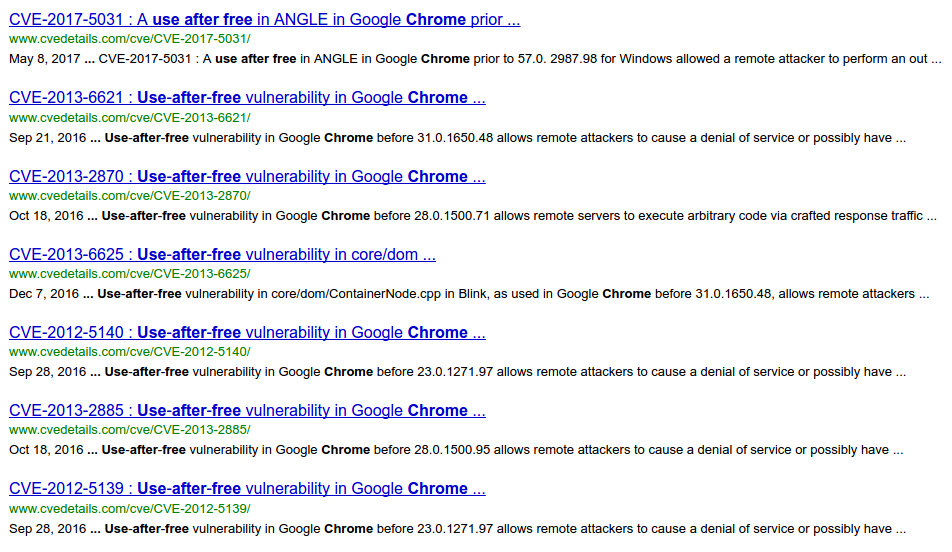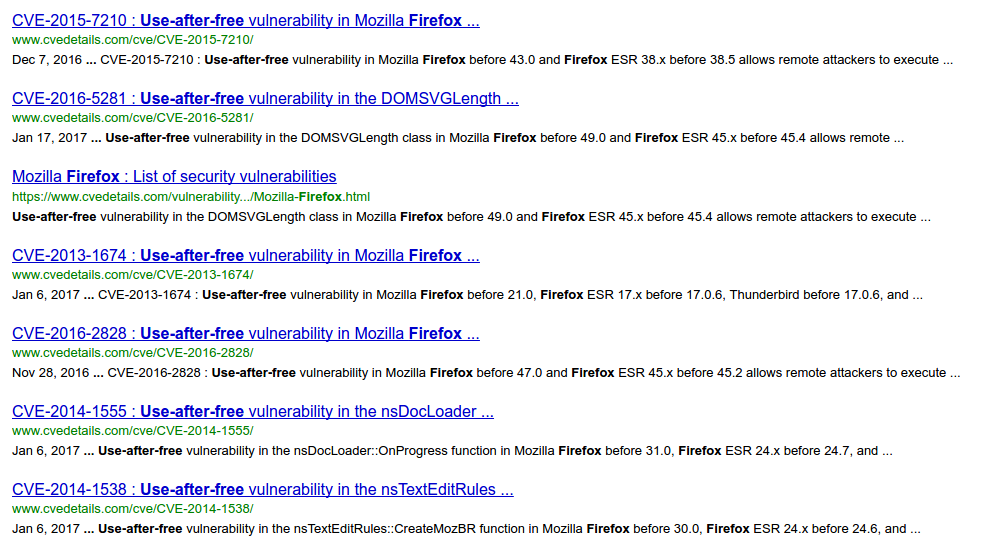Intro
After analysing the implementation of ptmalloc2 which, is a must read if you don’t know anything about the linux userland heap, I decided that for the second part of it, I would approach it as in a series of blog posts. Why? You might ask. Well it is easy for someone to tackle a problem in bite sized “chunks”. Understanding the heaps can be difficult and each of the techniques to be described in this series takes a decent amount of time to learn, understand and practice. Also, it is easier to find 15 minutes in a day rather than a few hours in a day. Also – hack the system.
Please note that it is not needed, but having a rough knowledge of programming and how pointers work in C code is a great shortcut to understand the examples given in this series.
The Vulnerability
Preface
To start this series we are going to cover one specific type of use-after-invalidation vulnerability because of its fame and presence. Going through www.cvedetails.com and searching for two of the most used browsers (Chrome and Firefox) yields many CVE’s involving this specific vulnerability: The use-after-free.


It is one of the most common vulnerabilities, if not the most, which is involved in heap exploitation, and it is the most likely to end up in arbitrary code execution from an attacker’s perspective.g
An example of the fame and wide presence of such vulnerabilities is the very recent CVE-2017-8540 found by Ian Beer @ Google’s Project Zero.
What
The use-after-free vulnerability is a use-after-invalidation vulnerability[1] where free is the invalid state of use. In human-readable language this means that at some point of the implementation there was a logic flaw that caused a free() on a chunk, but despite being free()’d, its memory position is still referenced, effectively making use of the free’d chunk’s data after it has been set free.
The implications of this type of vulnerability, and this is a cliché phrase when talking about heap exploitation, are endless; Pointer dereference leading to arbitrary write-what-where, leaking memory to defeat memory address randomisation (ASLR), dangling pointers, etc. And in some critical cases, pointer dereferences to functions. Let’s see some examples!
When stars align
To exploit a use-after-free vulnerability the most basic scenario I can think of is the following:
1 – Allocate MALLOC1: First an allocation is done in which we provide our own structure (pointer_malloc1) that has a function pointer allocated in the heap.
+---HEAP GROWS UPWARDS | +--- pointer_malloc1->good_function() | +-+-+-+-+-+-+ | | | MALLOC 1 |<--+ | +-----------+ | | TOP | | | | V | | +-----------+ --- WILDERNESS ---
2 – Free MALLOC1: free() the memory occupied by our first MALLOC1.
+---HEAP GROWS UPWARDS | +--- pointer_malloc1->good_function() | +-+-+-+-+-+-+ | | | FREE 1 |<--+ | +-----------+ | | TOP | | | | V | | +-----------+ --- WILDERNESS ---
3 – Allocate a malicious chunk MALLOC2 of the same size as MALLOC1: As we know from the previous post, chunks will be allocated by size and so, for our malicious chunk to take the place of old MALLOC1 it has to be of the same size.
+---HEAP GROWS UPWARDS | +--- pointer_malloc1->good_function() | +-+-+-+-+-+-+ | | | MALLOC 2 |<--+--- pointer_malloc2->evil_function() | +-----------+ | | TOP | | | | V | | +-----------+ --- WILDERNESS ---
4 – Reference old MALLOC1 (by mistake): Now that we allocated our own payload inside the MALLOC2 we expect the program’s implementation to call pointer_malloc1->good_function() which is actually pointing to our malicious MALLOC2 and so, it will actually call our pointer_malloc2->evil_function() because of the “short circuit” happening at (1).
+---HEAP GROWS UPWARDS | +--- pointer_malloc1->good_function() | +-+-+-+-+-+-+ | | | MALLOC 2 |<-(1)-- pointer_malloc2->evil_function() | +-----------+ | | TOP | | | | V | | +-----------+ --- WILDERNESS ---
The avid and experienced reader could point out something that my colleague, Saif, pointed out: This is a pointer dereference called dangling-pointer. When the dangling-pointer is then used it becomes a use-after-free.
The playground
Now on to the fun! Three snippets of code are provided here: Two of them exploiting the lack of security checks on ptmalloc2’s implementation (those security checks are left for the programmer to implement in order to keep ptmalloc2 performance at an acceptable level) and a third one left as a simple exercise for the reader to exploit a use-after-free vulnerable application.
Proof of Concepts
Basic UAF 1
Despite the fact that the following code might not be too appealing or realistic, this could happen in a scripting environment where we could cause an use-after-free within a library translating the following code to our target scripting environment (For example, JavaScript). But let’s not dwell into complex stuff yet as simplicity is key to understand the following.
In the beginning of the code I have defined a struct which is a composite data type. This means it can contain different types of data within itself, even other structs. In our case we have a simple struct containing a pointer to a function that returns nothing (i.e. returns void). This struct is the one that we will be (ab)using freely, specifically the “vulnfunc” pointer.
typedef struct UAFME {
void (*vulnfunc)();
} UAFME;
Afterwards, we have global definitions for two functions that simply print two strings to the terminal. Our goal is to call bad() without explicitly initialising any pointers to it.
void good(){
printf("I AM GOOD :)\n");
}
void bad(){
printf("I AM BAD >:|\n");
}
The next is an excerpt of main and it involves the allocation in memory of a chunk containing a pointer (1) to a struct of the aforementioned type: UAFME. The vulnfunc of said UAFME struct is set to the good function (2) so that when we call malloc1->vulnfunc(), the good function will be called (3).
UAFME *malloc1 = malloc(sizeof(UAFME)); // (1) malloc1->vulnfunc = good; // (2) malloc1->vulnfunc(); // (3)
Finally, we arrive to the exploitation part. Due to ptmalloc2 not checking the validity of the memory state of each variable, we can call malloc1->vulnfunc() again (1) even if its pointer has been free()’d (2) and so, it will actually use our malicious allocation (3) that we specifically craft by setting its contents to the pointer of bad() function (4).
free(malloc1); // (2) long *malloc2 = malloc(0); // (3) Zero allocation to confuse on purpose *malloc2 = (long)bad; // (4) malloc1->vulnfunc(); // BOOM! (1)
Let’s see it in action!
As you can see, it does print “I AM BAD >:|” at the end of the execution! This happens because we are using malloc1‘s pointer to call vulnfunc which actually is the pointer to the contents of malloc2. Eeeeviiiil.
Basic UAF 2
Now on a little bit more of a realistic scenario but keeping the same implementation, we are introducing a helper allocator function. On some software, programmers implement their own “safe” wrappers on top of malloc to prevent some vulnerabilities such as buffer overflows and unsafe free()s.
In our proof of concept, our developer tried to be tidy but, after a tiring day of work and a few hundred lines of code he forgot about something:
void helper_call_goodfunc(UAFME *uafme){
UAFME *private_uafme = uafme;
private_uafme->vulnfunc = good;
private_uafme->vulnfunc();
free(private_uafme);
}
Can you spot it? Spoiler: The solution is in the comments of the file basic_uaf_2.c.
Now you
I have put a challenge on 46.101.80.6 on ports 10000 to 10004. The goal is to make the program spit out the flag by using an already free()’d variable. Try it out!
The challenge is not up anymore. You can still try with the code on github. Do not hesitate on sending me any further questions you might have.
The flag is in the form: SP{contents_of_the_flag}
Hints
– There is one chunk already allocated at the beginning!
– Bear in mind that all addresses are 64bit. This means 8 bytes.
– Don’t forget (little) endianness
– Chunks are pointers to a pointer to an array of char (string)
char ** strchunks[MAXCHUNKS];
– Yes, there is a double-free case but it is not exploitable
– Yes and no, if you could leak addresses and knew the offset to libc, you could probably get a shell :)
Happy pwning!!!
Further reading
[1] Ode to the use-after-free by Chris Evans @ Google Project Zero


